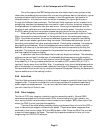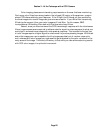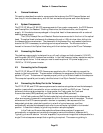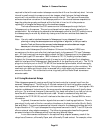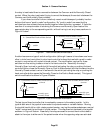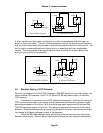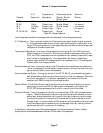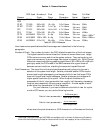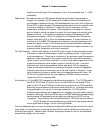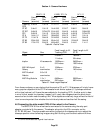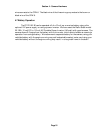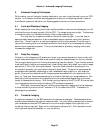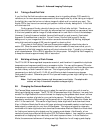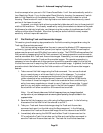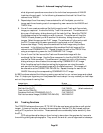Section 4 - Camera Hardware
Page 29
length is the focal length of the telescope or lens. Also remember that 1° = 3600
arcseconds.
Read Noise - The readout noise of a CCD camera affects the graininess of short exposure
images. For example, a CCD camera with a readout noise of 30 electrons will
give images of objects producing 100 photoelectrons (very dim!) with a Signal to
Noise (S/N) of approximately 3 whereas a perfect camera with no readout noise
would give a Signal to Noise of 10. Again, this is only important for short
exposures or extremely dim objects. As the exposure is increased you rapidly
get into a region where the signal to noise of the final image is due solely to the
exposure interval. In the previous example increasing the exposure to 1000
photoelectrons results in a S/N of roughly 20 on the camera with 30 electrons
readout noise and a S/N of 30 on the noiseless camera. It is also important to
note that with the SBIG CCD cameras the noise due to the sky background will
exceed the readout noise in 15 to 60 seconds on the typical amateur telescopes.
Even the $30,000 priced CCD cameras with 10 electrons of readout noise will not
produce a better image after a minute of exposure!
Full Well Capacity - The full well capacity of the CCD is the number of electrons each pixel can
hold before it starts to loose charge or bleed into adjacent pixels. Larger pixels
hold more electrons. This gives an indication of the dynamic range the camera is
capable of when compared to the readout noise, but for most astronomers this
figure of merit is not all that important. You will rarely takes images that fill the
pixels to the maximum level except for stars in the field of view. Low level
nebulosity will almost always be well below saturation. While integrating
longer would cause more build up of charge, the signal to noise of images like
these is proportional to the square-root of the total number of electrons. To get
twice the signal to noise you would have to increase the exposure 4 times. An
ST-5C with its relatively low full well capacity of 50,000e
-
could produce an
image with a S/N in excess of 200!
Antiblooming - All the SBIG CCD cameras have antiblooming protection. The TI CCDs used in
the ST-5C, ST-237 and ST-6 have it built into the CCDs and the Kodak CCDs
used in the ST-7E and ST-8E have Antiblooming versions of the CCDs available.
Blooming is a phenomenon that occurs when pixels fill up. As charge continues
to be generated in a full pixel, it has to go somewhere. In CCDs without
antiblooming protection the charge spills into neighboring pixels, causing bright
streaks in the image. With the CCDs used in the SBIG cameras the excess charge
can be drained off saturated pixels by applying clocking to the CCD during
integration. This protection allows overexposures of 100-fold without blooming.
The ST-9E does not have antiblooming protection but the large pixels can
hold a great deal of charge. It's not a limiting problem.
From the telescope's point of view, the different models offer differing fields of view for a given
focal length, or turned around, to achieve the same field of view the different models require
differing focal lengths. Tables 4.4 and 4.5 below compare the fields of view for the cameras at
several focal lengths, and vice versa.



